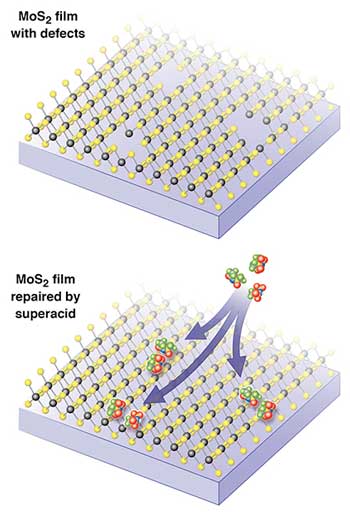| Posted: Apr 10, 2018 |
Superacids are good medicine for super thin semiconductors
(Nanowerk News) Designing wearable sensors or other devices demands robust, flexible electronics. Extremely thin films, just one atom thick, such as molybdenum disulfide (MoS2), hold promise. Large-area synthesis of these materials is required for their commercialization. But today’s thin films are plagued by structural defects. These defects degrade device performance.
|
|
Scientists at New York University and the Center for Functional Nanomaterials have implemented a superacid treatment for healing defects in thin MoS2 films. They showed that this straightforward chemical treatment is compatible with electronic device fabrication (Applied Physics Letters, "Material and device properties of superacid-treated monolayer molybdenum disulfide").
Also, the process boosts device performance by reducing the density of defects in the material.
|
 |
| (Top) Illustration shows a 2-D molybdenum disulfide (MoS2) semiconductor with structural defects such as missing surface atoms. (Bottom) Treating the 2-D semiconductor with a superacid heals structural defects and improves the electronic performance of the material. (Image: Brookhaven National Laboratory)
|
|
Wearable computers are an emerging trend. To capitalize on this trend, industry needs mechanically flexible devices. Thin films can enable power-efficient and high-speed devices. This work is a vital step toward realizing wearable devices.
|
|
The atomically thin nature of layered 2-D semiconductors gives rise to a gamut of unique physical properties, which often do not exist in traditional bulk semiconductors such as silicon. These physical properties can enable a new family of devices, from sensors to logic switches, that have superior performance compared with their conventional counterparts.
|
|
Producing defect-free 2-D materials on a large scale underpins the translation of basic scientific studies into real products. However, synthetic 2-D materials are plagued with large numbers of defects that suppress many of their useful properties.
|
|
In the ongoing quest to achieve large defect-free 2-D semiconductors, scientists at New York University have shown that a superacid treatment boosts the performance of devices made from monolayer 2-D MoS2. In collaboration with scientists at the Center for Functional Nanomaterials, they used an advanced material characterization technique, called Nano-Auger, to study the structure of 2-D MoS2 on the atomic scale. They discovered that the superacid treatment is mostly effective in healing defects in the regions of MoS2 that have missing sulfur atoms.
|
|
These findings are important steps toward realizing high-performance devices from synthetic 2-D semiconductors.
|

